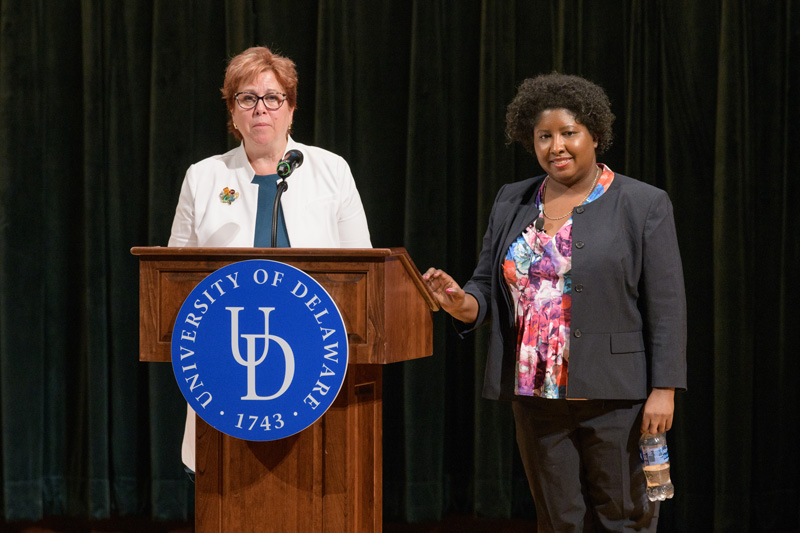


Barriers to the voting booth
Photo by Evan Krape and iStock October 16, 2018
People with disabilities often stymied when trying to vote, panelists say
People with disabilities “tend to be among the most disempowered populations in America,” said Stanford Law School’s Rabia Belt at a civil liberties discussion hosted on Tuesday, Oct. 9 by the University of Delaware’s Center for Disabilities Studies. And nowhere is there greater evidence of that marginalization, Belt and her fellow panelists said, than in the pervasive barriers that keep people with disabilities from voting.
Belt, who also delivered a solo presentation on campus Tuesday on current voting rights controversies, was joined at the forum by three leaders from Washington, D.C.-based disability and voting rights advocacy organizations, and Delaware Attorney General Matt Denn. CDS Director Beth Mineo moderated the forum and presentation, held on the occasion of the Center’s 25-year anniversary.
While the panelists cited numerous examples of social injustices and inadequate accommodations that they said have suppressed voting among people with disabilities, they also suggested remedies, beginning with increased education and political participation.
Belt traced a history of disability-based disenfranchisement in the United States to an early 1900s movement that segregated people with disabilities in institutions, effectively severing them from the political community.
In the intervening decades, cultural attitudes shifted to emphasize social inclusion, but electoral access has lagged behind. A 2016 Government Accountability Office report on the experiences of voters with disabilities found that 60 percent of polling places examined had at least one accessibility barrier.
Panelists characterized such findings as evidence that disability rights still rate far below those of other constituencies.
“If 60 percent of polling places were accessible to only men or white people, this would not stand,” said Michelle Bishop, voting rights specialist with the National Disability Rights Network.
The inclusion advisor for the International Foundation for Election Systems, Virginia Atkinson, said that voters with disabilities faced similarly dismissive or lax attitudes in democracies across the globe. Atkinson, who led the creation of an election accessibility handbook and website, recalled one international election watchdog organization that rated polling places “accessible” if they had “only” two or three stairs up to the entrance.
And while physical accessibility is one of the most visible voting barriers, it is hardly the only impediment people with disabilities face at the polls. Long lines, panelists noted, pose serious health risks to voters with behavioral challenges and veterans with PTSD, who may have difficulty standing in crowds or enclosed spaces.
Even well-intentioned accommodations are useless if their designers and operators aren’t sensitive to the needs of voters with disabilities, the panel’s elections specialists said. The 2002 Help America Vote Act, for example, mandates every polling place in the U.S. contain at least one accessible voting machine, yet different disabilities – difficulties with hearing, vision, cognition, movement – can lead to vastly different accommodation needs.
All voting accommodations also rely on election workers, who can themselves present barriers.
“Poll workers are typically not trained to assist people with disabilities,” said Atkinson, “and consequently assistive voting devices often go unused.”
While panelists said that educating election officials is relatively straightforward, battling the assumptions and prejudices that inform voting policy and enforcement is a much thornier task.
Judges in 40 states – including Delaware – can with the stroke of a pen disenfranchise certain people with cognitive disabilities based on an arbitrary determination of mental competence. “People with disabilities are the only demographic left,” said Bishop, “who can have their right to vote taken away based solely on their identity.”
In other cases, people with disabilities lose their votes to caretakers or administrators of long-term living facilities. Several legitimate cases of voter fraud in the U.S. center on caretakers who fill out ballots in the names of their clients.
Helena Berger, the president and CEO of the American Association of People with Disabilities, said enforcing the voting protections that do exist is often a discouraging process that puts much of the onus on the people with disabilities trying to reclaim their rights.
With so many potential obstacles and indignities, it’s no wonder that people with disabilities disengage from politics, said Belt. She asked, “If you have one bad experience, why would you want to go back?”
One way forward is to build awareness, said Denn. He attributed recent state disability legislation to relationships between politicians and people with disabilities. “Legislators from both parties have personal connections to people with disabilities,” he said.
Nevertheless, he recalled that disability policy rarely plays a role in campaigns. There is a “compelling need to make sure that people are asked the right questions when they run and are held accountable,” he said.
Berger, whose organization spearheaded the REV UP campaign to educate voters with disabilities and encourage them to turn out on Election Day, said that it is essential for people with disabilities to engage in politics themselves if they want to see change.
“We need to do a better job educating people with disabilities about issues that impact them,” she said, “as well as helping them to politically organize and mobilize.”
She said that more people with disabilities than ever are running for office. However, the closest estimate, which comes from the National Council on Independent Living, is 76, encompassing candidates nationwide running in local, state and federal elections. By contrast, there were 2,665 candidates participating in the 2018 elections as of Oct. 5 – and that’s just at the federal level.
“Decisions are being made for people with disabilities and their families without benefit of their perspective,” said CDS’s Mineo. We can chip away at that, she said, through greater civic engagement.
Contact Us
Have a UDaily story idea?
Contact us at ocm@udel.edu
Members of the press
Contact us at 302-831-NEWS or visit the Media Relations website

